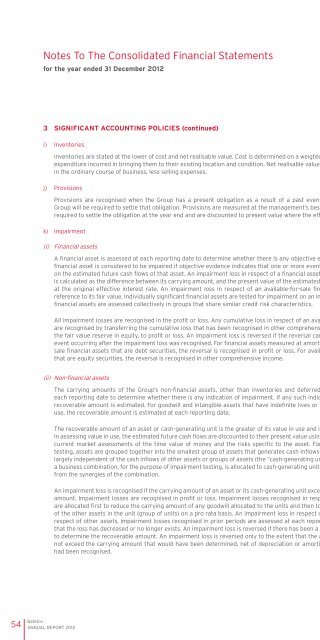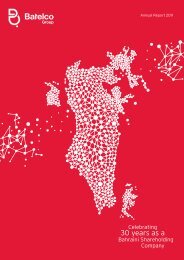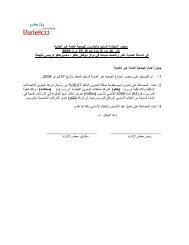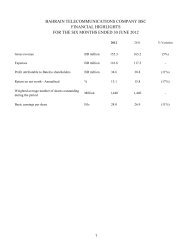to download the latest Annual Report in PDF (2.2 MB) - Batelco Group
to download the latest Annual Report in PDF (2.2 MB) - Batelco Group
to download the latest Annual Report in PDF (2.2 MB) - Batelco Group
Create successful ePaper yourself
Turn your PDF publications into a flip-book with our unique Google optimized e-Paper software.
Notes To The Consolidated F<strong>in</strong>ancial Statements<br />
for <strong>the</strong> year ended 31 December 2012<br />
Notes To The Consolidated F<strong>in</strong>ancial Statements<br />
for <strong>the</strong> year ended 31 December 2012<br />
3 SIGNIFICANT ACCOUNTING POLICIES (cont<strong>in</strong>ued)<br />
i) Inven<strong>to</strong>ries<br />
Inven<strong>to</strong>ries are stated at <strong>the</strong> lower of cost and net realisable value. Cost is determ<strong>in</strong>ed on a weighted average basis and <strong>in</strong>cludes<br />
expenditure <strong>in</strong>curred <strong>in</strong> br<strong>in</strong>g<strong>in</strong>g <strong>the</strong>m <strong>to</strong> <strong>the</strong>ir exist<strong>in</strong>g location and condition. Net realisable value is <strong>the</strong> estimated sell<strong>in</strong>g price<br />
<strong>in</strong> <strong>the</strong> ord<strong>in</strong>ary course of bus<strong>in</strong>ess, less sell<strong>in</strong>g expenses.<br />
j) Provisions<br />
Provisions are recognised when <strong>the</strong> <strong>Group</strong> has a present obligation as a result of a past event and it is probable that <strong>the</strong><br />
<strong>Group</strong> will be required <strong>to</strong> settle that obligation. Provisions are measured at <strong>the</strong> management’s best estimate of <strong>the</strong> expenditure<br />
required <strong>to</strong> settle <strong>the</strong> obligation at <strong>the</strong> year end and are discounted <strong>to</strong> present value where <strong>the</strong> effect is material.<br />
k) Impairment<br />
(i) F<strong>in</strong>ancial assets<br />
A f<strong>in</strong>ancial asset is assessed at each report<strong>in</strong>g date <strong>to</strong> determ<strong>in</strong>e whe<strong>the</strong>r <strong>the</strong>re is any objective evidence that it is impaired. A<br />
f<strong>in</strong>ancial asset is considered <strong>to</strong> be impaired if objective evidence <strong>in</strong>dicates that one or more events have had a negative effect<br />
on <strong>the</strong> estimated future cash flows of that asset. An impairment loss <strong>in</strong> respect of a f<strong>in</strong>ancial asset measured at amortised cost<br />
is calculated as <strong>the</strong> difference between its carry<strong>in</strong>g amount, and <strong>the</strong> present value of <strong>the</strong> estimated future cash flows discounted<br />
at <strong>the</strong> orig<strong>in</strong>al effective <strong>in</strong>terest rate. An impairment loss <strong>in</strong> respect of an available-for-sale f<strong>in</strong>ancial asset is calculated by<br />
reference <strong>to</strong> its fair value. Individually significant f<strong>in</strong>ancial assets are tested for impairment on an <strong>in</strong>dividual basis. The rema<strong>in</strong><strong>in</strong>g<br />
f<strong>in</strong>ancial assets are assessed collectively <strong>in</strong> groups that share similar credit risk characteristics.<br />
All impairment losses are recognised <strong>in</strong> <strong>the</strong> profit or loss. Any cumulative loss <strong>in</strong> respect of an available-for-sale f<strong>in</strong>ancial asset<br />
are recognised by transferr<strong>in</strong>g <strong>the</strong> cumulative loss that has been recognised <strong>in</strong> o<strong>the</strong>r comprehensive <strong>in</strong>come, and presented <strong>in</strong><br />
<strong>the</strong> fair value reserve <strong>in</strong> equity, <strong>to</strong> profit or loss. An impairment loss is reversed if <strong>the</strong> reversal can be related objectively <strong>to</strong> an<br />
event occurr<strong>in</strong>g after <strong>the</strong> impairment loss was recognised. For f<strong>in</strong>ancial assets measured at amortised cost and available-forsale<br />
f<strong>in</strong>ancial assets that are debt securities, <strong>the</strong> reversal is recognised <strong>in</strong> profit or loss. For available-for-sale f<strong>in</strong>ancial assets<br />
that are equity securities, <strong>the</strong> reversal is recognised <strong>in</strong> o<strong>the</strong>r comprehensive <strong>in</strong>come.<br />
(ii) Non-f<strong>in</strong>ancial assets<br />
The carry<strong>in</strong>g amounts of <strong>the</strong> <strong>Group</strong>’s non-f<strong>in</strong>ancial assets, o<strong>the</strong>r than <strong>in</strong>ven<strong>to</strong>ries and deferred tax assets, are reviewed at<br />
each report<strong>in</strong>g date <strong>to</strong> determ<strong>in</strong>e whe<strong>the</strong>r <strong>the</strong>re is any <strong>in</strong>dication of impairment. If any such <strong>in</strong>dication exists, <strong>the</strong>n <strong>the</strong> asset’s<br />
recoverable amount is estimated. For goodwill and <strong>in</strong>tangible assets that have <strong>in</strong>def<strong>in</strong>ite lives or that are not yet available for<br />
use, <strong>the</strong> recoverable amount is estimated at each report<strong>in</strong>g date.<br />
The recoverable amount of an asset or cash-generat<strong>in</strong>g unit is <strong>the</strong> greater of its value <strong>in</strong> use and its fair value less costs <strong>to</strong> sell.<br />
In assess<strong>in</strong>g value <strong>in</strong> use, <strong>the</strong> estimated future cash flows are discounted <strong>to</strong> <strong>the</strong>ir present value us<strong>in</strong>g a discount rate that reflects<br />
current market assessments of <strong>the</strong> time value of money and <strong>the</strong> risks specific <strong>to</strong> <strong>the</strong> asset. For <strong>the</strong> purpose of impairment<br />
test<strong>in</strong>g, assets are grouped <strong>to</strong>ge<strong>the</strong>r <strong>in</strong><strong>to</strong> <strong>the</strong> smallest group of assets that generates cash <strong>in</strong>flows from cont<strong>in</strong>u<strong>in</strong>g use that are<br />
largely <strong>in</strong>dependent of <strong>the</strong> cash <strong>in</strong>flows of o<strong>the</strong>r assets or groups of assets (<strong>the</strong> “cash-generat<strong>in</strong>g unit”). The goodwill acquired <strong>in</strong><br />
a bus<strong>in</strong>ess comb<strong>in</strong>ation, for <strong>the</strong> purpose of impairment test<strong>in</strong>g, is allocated <strong>to</strong> cash-generat<strong>in</strong>g units that are expected <strong>to</strong> benefit<br />
from <strong>the</strong> synergies of <strong>the</strong> comb<strong>in</strong>ation.<br />
An impairment loss is recognised if <strong>the</strong> carry<strong>in</strong>g amount of an asset or its cash-generat<strong>in</strong>g unit exceeds its estimated recoverable<br />
amount. Impairment losses are recognised <strong>in</strong> profit or loss. Impairment losses recognised <strong>in</strong> respect of cash-generat<strong>in</strong>g units<br />
are allocated first <strong>to</strong> reduce <strong>the</strong> carry<strong>in</strong>g amount of any goodwill allocated <strong>to</strong> <strong>the</strong> units and <strong>the</strong>n <strong>to</strong> reduce <strong>the</strong> carry<strong>in</strong>g amount<br />
of <strong>the</strong> o<strong>the</strong>r assets <strong>in</strong> <strong>the</strong> unit (group of units) on a pro rata basis. An impairment loss <strong>in</strong> respect of goodwill is not reversed. In<br />
respect of o<strong>the</strong>r assets, impairment losses recognised <strong>in</strong> prior periods are assessed at each report<strong>in</strong>g date for any <strong>in</strong>dications<br />
that <strong>the</strong> loss has decreased or no longer exists. An impairment loss is reversed if <strong>the</strong>re has been a change <strong>in</strong> <strong>the</strong> estimates used<br />
<strong>to</strong> determ<strong>in</strong>e <strong>the</strong> recoverable amount. An impairment loss is reversed only <strong>to</strong> <strong>the</strong> extent that <strong>the</strong> asset’s carry<strong>in</strong>g amount does<br />
not exceed <strong>the</strong> carry<strong>in</strong>g amount that would have been determ<strong>in</strong>ed, net of depreciation or amortisation, if no impairment loss<br />
had been recognised.<br />
3 SIGNIFICANT ACCOUNTING POLICIES (cont<strong>in</strong>ued)<br />
l) Employee benefits<br />
(i) Local employees<br />
Pension rights and o<strong>the</strong>r social benefits for <strong>the</strong> <strong>Group</strong>’s employees are covered by <strong>the</strong> applicable social <strong>in</strong>surance scheme of<br />
<strong>the</strong> countries <strong>in</strong> which <strong>the</strong>y are employed are considered as a def<strong>in</strong>ed contribution scheme. The employees and employers<br />
contribute monthly <strong>to</strong> <strong>the</strong> scheme on a fixed-percentage-of-salaries basis.<br />
(ii) Expatriate employees<br />
Expatriate employees on limited-term contracts are entitled <strong>to</strong> leav<strong>in</strong>g <strong>in</strong>demnities payable under <strong>the</strong> respective labour laws<br />
of <strong>the</strong> countries <strong>in</strong> which <strong>the</strong>y are employed, based on length of service and f<strong>in</strong>al remuneration. Provision for this unfunded<br />
commitment has been made by calculat<strong>in</strong>g <strong>the</strong> notional liability had all employees left at <strong>the</strong> report<strong>in</strong>g date.<br />
(iii) Employee sav<strong>in</strong>gs scheme<br />
The Company has a voluntary employees sav<strong>in</strong>g scheme. The employees and employers contribute monthly on a fixedpercentage-of-salaries-basis<br />
<strong>to</strong> <strong>the</strong> scheme.<br />
m) Tax<br />
Tax expense comprises current and deferred tax. Income tax expense is recognised <strong>in</strong> <strong>the</strong> profit or loss except <strong>to</strong> <strong>the</strong> extent that<br />
it relates <strong>to</strong> items recognised directly <strong>in</strong> equity or <strong>in</strong> o<strong>the</strong>r comprehensive <strong>in</strong>come, <strong>in</strong> which case it is recognised <strong>in</strong> equity or<br />
o<strong>the</strong>r comprehensive <strong>in</strong>come.<br />
(i) Current tax<br />
Current tax is <strong>the</strong> expected tax payable on <strong>the</strong> taxable <strong>in</strong>come for <strong>the</strong> year, us<strong>in</strong>g tax rates enacted or substantively enacted at<br />
<strong>the</strong> report<strong>in</strong>g date, and any adjustment <strong>to</strong> tax payable <strong>in</strong> respect of previous years.<br />
(ii) Deferred tax<br />
Deferred tax is recognised <strong>in</strong> respect of temporary differences between <strong>the</strong> carry<strong>in</strong>g amounts of assets and liabilities for f<strong>in</strong>ancial<br />
report<strong>in</strong>g purposes and <strong>the</strong> amounts used for taxation purposes. Deferred tax is measured at <strong>the</strong> tax rates that are expected <strong>to</strong><br />
be applied <strong>to</strong> <strong>the</strong> temporary differences when <strong>the</strong>y reverse, based on <strong>the</strong> laws that have been enacted or substantively enacted<br />
by <strong>the</strong> report<strong>in</strong>g date. Deferred tax assets and liabilities are offset if <strong>the</strong>re is a legally enforceable right <strong>to</strong> offset current tax<br />
liabilities and assets, and <strong>the</strong>y relate <strong>to</strong> <strong>in</strong>come taxes levied by <strong>the</strong> same tax authority on <strong>the</strong> same taxable entity, or on different<br />
tax entities, but <strong>the</strong>y <strong>in</strong>tend <strong>to</strong> settle current tax liabilities and assets on a net basis or <strong>the</strong>ir tax assets and liabilities will be<br />
realised simultaneously.<br />
A deferred tax asset is recognised <strong>to</strong> <strong>the</strong> extent that it is probable that future taxable profits will be available aga<strong>in</strong>st which <strong>the</strong><br />
temporary difference can be realised. Deferred tax assets are reviewed at each report<strong>in</strong>g date and are reduced <strong>to</strong> <strong>the</strong> extent<br />
that it is no longer probable that <strong>the</strong> related tax benefit will be realised. Additional <strong>in</strong>come taxes that arise from <strong>the</strong> distribution<br />
of dividends are recognised at <strong>the</strong> same time as <strong>the</strong> liability <strong>to</strong> pay <strong>the</strong> related dividend is recognised.<br />
n) Revenue<br />
Revenue represents <strong>the</strong> value of fixed or determ<strong>in</strong>able consideration that has been received or is receivable and <strong>in</strong>cludes<br />
revenue from revenue shar<strong>in</strong>g arrangements entered <strong>in</strong><strong>to</strong> with national and <strong>in</strong>ternational telecommunication opera<strong>to</strong>rs <strong>in</strong><br />
respect of traffic exchanged.<br />
Revenue for services rendered is stated at amounts <strong>in</strong>voiced <strong>to</strong> cus<strong>to</strong>mers. Fees for <strong>in</strong>stallation and activation are recognised<br />
as revenue upon activation. All <strong>in</strong>stallation and activation costs are expensed as <strong>in</strong>curred. Monthly service revenue received<br />
from <strong>the</strong> cus<strong>to</strong>mer is recognised <strong>in</strong> <strong>the</strong> period <strong>in</strong> which <strong>the</strong> service is delivered. Airtime revenue is recognised on <strong>the</strong> usage<br />
basis. Revenue from data services is recognised when <strong>the</strong> <strong>Group</strong> has performed <strong>the</strong> related service and, depend<strong>in</strong>g on <strong>the</strong><br />
nature of <strong>the</strong> service, is recognized ei<strong>the</strong>r at <strong>the</strong> gross amount billed <strong>to</strong> <strong>the</strong> cus<strong>to</strong>mer or <strong>the</strong> amount receivable by <strong>the</strong> <strong>Group</strong><br />
as commission for facilitat<strong>in</strong>g <strong>the</strong> service. Revenue from handset and o<strong>the</strong>r equipment sales is recognised when <strong>the</strong> product is<br />
delivered <strong>to</strong> <strong>the</strong> cus<strong>to</strong>mer.<br />
54<br />
<strong>Batelco</strong><br />
ANNUAL REPORT 2012<br />
<strong>Batelco</strong><br />
ANNUAL REPORT 2012<br />
55















